Ichthyoplankton sampling is done on all survey cruises and processing of these samples is done at the Southwest Fisheries Science Center (SWFSC) laboratory in La Jolla, California. There, plankton displacement volumes are obtained for each sample and the fish eggs, larvae, and juveniles are separated from the invertebrate zooplankton, and subsequently identified, staged, measured. The resulting data form the CalCOFI Ichthyoplankton Data Base. The fish eggs, larvae, and juveniles are archived in the SWFSC Ichthyplankton Collection and the invertebrate plankton is transferred to the Scripps Institution of Oceanography Invertebrate Collection. CalCOFI surveys are the basis for NMFS research on the population biology of the major coastal pelagic fishes (Pacific sardine, northern anchovy, hake, Pacific mackerel, and jack mackerel) of the California Current System.
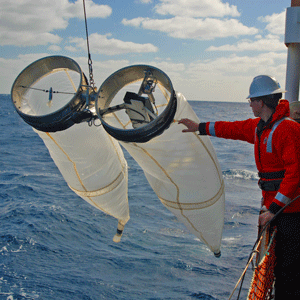 Southwest Fisheries Science Center collects CalBOBL net tow samples for all CalCOFI and SCCOOS stations. The CalBOBL (Bongo) net, referred to as CB in the CalCOFI database, has been the standard sampler since replacing the CAL1MOBL in 1978. The net frame is connected to a central yoke which is swivel-shackled to the winch tow cable. The central yoke makes this sampler a "bridle-free net" which allows the mouth openings to fish horizontally during the oblique tow.
Southwest Fisheries Science Center collects CalBOBL net tow samples for all CalCOFI and SCCOOS stations. The CalBOBL (Bongo) net, referred to as CB in the CalCOFI database, has been the standard sampler since replacing the CAL1MOBL in 1978. The net frame is connected to a central yoke which is swivel-shackled to the winch tow cable. The central yoke makes this sampler a "bridle-free net" which allows the mouth openings to fish horizontally during the oblique tow.
Read More
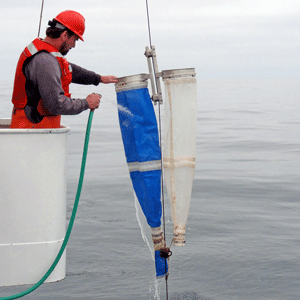 A Pairovet vertical plankton tow is performed at all stations inshore of, and including station 70. The Pairovet net fishes from 70 meters to the surface (depth permitting) using paired 25 cm diameter 150 um mesh nets. The technical requirements for Pairovet tows are: Descent rate of 70 meters per minute, ascent rate of 70 meters per minute. All tows with wire angles exceeding 15 degrees during the ascent will be repeated.
A Pairovet vertical plankton tow is performed at all stations inshore of, and including station 70. The Pairovet net fishes from 70 meters to the surface (depth permitting) using paired 25 cm diameter 150 um mesh nets. The technical requirements for Pairovet tows are: Descent rate of 70 meters per minute, ascent rate of 70 meters per minute. All tows with wire angles exceeding 15 degrees during the ascent will be repeated.
Read More
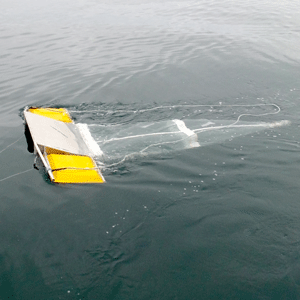 The twin winged continuous-flow surface tow, referred to as MT in the CalCOFI database, samples ~8cm of the ocean surface, minimizing wake disturbance from the ship. The MANTA Net is an improved design from the Neuston Net and is capable of continuous-flow collection of organisms at the ocean surface.
The twin winged continuous-flow surface tow, referred to as MT in the CalCOFI database, samples ~8cm of the ocean surface, minimizing wake disturbance from the ship. The MANTA Net is an improved design from the Neuston Net and is capable of continuous-flow collection of organisms at the ocean surface.
Read More
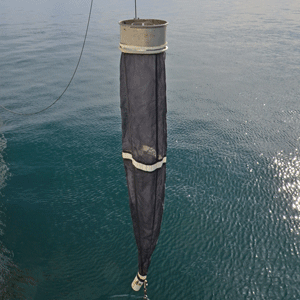 A Planktonic Rate Processes in Oligotrophic Ocean Systems (PRPOOS) net, formerly known as the Soutar-Hemingway Animal Trap or "SHAT" (Kramer 1972), is a 202 µm mesh net that has a 50 cm diameter single frame opening and is 3 m in length. The PRPOOS net deployment is a vertical tow lowered into the water to 210 m. The descent rate is 40 meters per minute to depth, 20 seconds at depth and has an ascent rate of 50 meters per minute.
A Planktonic Rate Processes in Oligotrophic Ocean Systems (PRPOOS) net, formerly known as the Soutar-Hemingway Animal Trap or "SHAT" (Kramer 1972), is a 202 µm mesh net that has a 50 cm diameter single frame opening and is 3 m in length. The PRPOOS net deployment is a vertical tow lowered into the water to 210 m. The descent rate is 40 meters per minute to depth, 20 seconds at depth and has an ascent rate of 50 meters per minute.
Read More
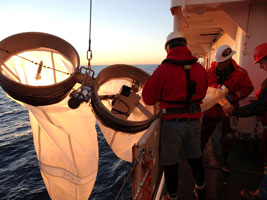

 Southwest Fisheries Science Center collects CalBOBL net tow samples for all CalCOFI and SCCOOS stations. The CalBOBL (Bongo) net, referred to as CB in the CalCOFI database, has been the standard sampler since replacing the CAL1MOBL in 1978. The net frame is connected to a central yoke which is swivel-shackled to the winch tow cable. The central yoke makes this sampler a "bridle-free net" which allows the mouth openings to fish horizontally during the oblique tow.
Southwest Fisheries Science Center collects CalBOBL net tow samples for all CalCOFI and SCCOOS stations. The CalBOBL (Bongo) net, referred to as CB in the CalCOFI database, has been the standard sampler since replacing the CAL1MOBL in 1978. The net frame is connected to a central yoke which is swivel-shackled to the winch tow cable. The central yoke makes this sampler a "bridle-free net" which allows the mouth openings to fish horizontally during the oblique tow. A Pairovet vertical plankton tow is performed at all stations inshore of, and including station 70. The Pairovet net fishes from 70 meters to the surface (depth permitting) using paired 25 cm diameter 150 um mesh nets. The technical requirements for Pairovet tows are: Descent rate of 70 meters per minute, ascent rate of 70 meters per minute. All tows with wire angles exceeding 15 degrees during the ascent will be repeated.
A Pairovet vertical plankton tow is performed at all stations inshore of, and including station 70. The Pairovet net fishes from 70 meters to the surface (depth permitting) using paired 25 cm diameter 150 um mesh nets. The technical requirements for Pairovet tows are: Descent rate of 70 meters per minute, ascent rate of 70 meters per minute. All tows with wire angles exceeding 15 degrees during the ascent will be repeated. The twin winged continuous-flow surface tow, referred to as MT in the CalCOFI database, samples ~8cm of the ocean surface, minimizing wake disturbance from the ship. The MANTA Net is an improved design from the Neuston Net and is capable of continuous-flow collection of organisms at the ocean surface.
The twin winged continuous-flow surface tow, referred to as MT in the CalCOFI database, samples ~8cm of the ocean surface, minimizing wake disturbance from the ship. The MANTA Net is an improved design from the Neuston Net and is capable of continuous-flow collection of organisms at the ocean surface. A Planktonic Rate Processes in Oligotrophic Ocean Systems (PRPOOS) net, formerly known as the Soutar-Hemingway Animal Trap or "SHAT" (Kramer 1972), is a 202 µm mesh net that has a 50 cm diameter single frame opening and is 3 m in length. The PRPOOS net deployment is a vertical tow lowered into the water to 210 m. The descent rate is 40 meters per minute to depth, 20 seconds at depth and has an ascent rate of 50 meters per minute.
A Planktonic Rate Processes in Oligotrophic Ocean Systems (PRPOOS) net, formerly known as the Soutar-Hemingway Animal Trap or "SHAT" (Kramer 1972), is a 202 µm mesh net that has a 50 cm diameter single frame opening and is 3 m in length. The PRPOOS net deployment is a vertical tow lowered into the water to 210 m. The descent rate is 40 meters per minute to depth, 20 seconds at depth and has an ascent rate of 50 meters per minute.